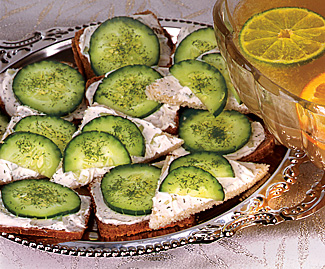Swedish researchers have tracked a human outbreak of the parasite, microsporidia, to raw cucumbers, and propose the most likely source was human manure during growing.
From the paper:
Our investigations suggest that cucumber slices in both cheese sandwiches and a salad were the most probable vehicle of transmission. Since no leftover food samples were available for testing and because little is known about E. bieneusi in the context of foodborne outbreaks, it is difficult to conclusively
implicate this organism as the agent responsible for the outbreak. However, the finding that all six samples available for genotyping were genetically indistinguishable (genotype C) together with the fact that, despite extensive  testing, no other organisms were identified in the stool samples strongly suggest that E. bieneusi was the causative agent. Furthermore, the finding that all 19 stool samples from persons belonging to the same professional group who had not attended the event were negative for microsporidia provides additional evidence that the detection of E. bieneusi was not a chance finding. Although these samples were taken 7 months after the event, they nevertheless provide an indication of the prevalence of microsporidia in a population with similar demographic characteristics.
testing, no other organisms were identified in the stool samples strongly suggest that E. bieneusi was the causative agent. Furthermore, the finding that all 19 stool samples from persons belonging to the same professional group who had not attended the event were negative for microsporidia provides additional evidence that the detection of E. bieneusi was not a chance finding. Although these samples were taken 7 months after the event, they nevertheless provide an indication of the prevalence of microsporidia in a population with similar demographic characteristics.
We cannot state with certainty how and where the sliced cucumbers were contaminated. Contamination during final preparation at the hotel seems unlikely because the cucumbers were not processed any further but were added directly to the sandwiches. Furthermore, a high contamination dose is suspected (due to high attack rate in a healthy population) which is unlikely to have occurred because preparation of the sandwiches was carried out by an asymptomatic food handler. The sealed bags of cucumber slices had been
refrigerated before use so it is improbable that contamination took place during storage. Similarly, contamination during initial processing at the wholesale supplier, although possible, seems unlikely based on the description of the procedures used. The most likely hypothesis of contamination is that it occurred before harvest, either by contaminated manure, manure compost, sewage sludge, irrigation water, runoff water from livestock operations or directly from wild and domestic animals. These potential contamination events are all plausible and consistent with the assumption that the level of contamination must have been high. Unfortunately, because we were unable to trace the cucumbers back to the farm where they were grown, we could not investigate these
possible contamination routes further. However, additional information is provided by the genotyping results. While there have been several cases of genotype C identified in humans, predominantly in HIV-negative organ transplant recipients in Europe [25, 26], there is only one report on animals in the
literature [27]. Thus, while a zoonotic link cannot be ruled out, the involvement of this genotype suggests that the source of contamination in this outbreak was
of human (fecal) origin.
While thorough washing of fresh produce remains of utmost importance in preventing foodborne illness and should continue to be emphasized, sometimes washing may be insufficient to remove all pathogens.
In this instance, it may have been that the level of contamination was so high that washing was unable to remove enough of the microbial load so as to prevent  infection. Alternatively, it may be that microsporidian spores are capable of strong adhesion to, or internalization in, certain types of produce, thereby
infection. Alternatively, it may be that microsporidian spores are capable of strong adhesion to, or internalization in, certain types of produce, thereby
successfully evading the effects of washing and disinfection.
A recent paper by researchers in the USA demonstrated that Cryptosporidium oocysts were capable of strongly adhering to spinach plants after contact with contaminated water and were also internalized within the leaves, thus making
entirely ineffective [28].
Abstract:
First reported foodborne outbreak associated with microsporidia, SWEDEN, October 2009
Epidemiology and Infection
V. Decraene, M. Lebbad, S. Botero-Kleiven, A.-M. Gustavsson and M. Löfdahl
http://journals.cambridge.org/action/displayAbstract?fromPage=online&aid=8271787
Abstract
Microsporidia are spore-forming intracellular parasites that infrequently cause disease in immunocompetent persons. This study describes the first report of a foodborne microsporidiosis outbreak which affected persons visiting a hotel in Sweden. Enterocytozoon bieneusi was identified in stool samples from 7/11 case-patients, all six sequenced samples were genotype C. To confirm that this was not a chance finding, 19 stool samples submitted by healthy persons from a comparable group who did not visit the hotel on that day were tested; all were negative for microsporidia. A retrospective cohort study identified 135 case-patients (attack rate 30%). The median incubation period was 9 days. Consumption of cheese sandwiches [relative risk (RR) 4·1, 95% confidence interval (CI) 1·4–12·2] and salad (RR 2·1, 95% CI 1·1–4) were associated with illness. Both items contained pre-washed, ready-to-eat cucumber slices. Microsporidia may be an under-reported cause of gastrointestinal outbreaks; we recommend that microsporidia be explored as potential causative agents in food- and waterborne outbreaks, especially when no other organisms are identified.
